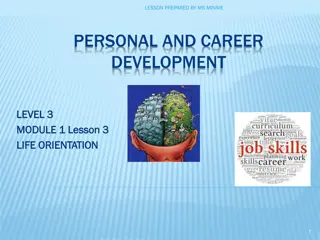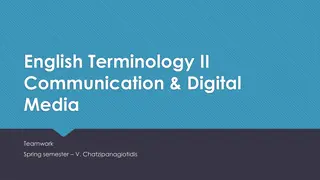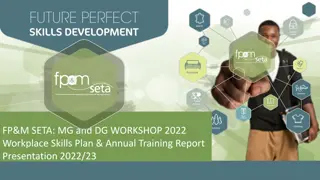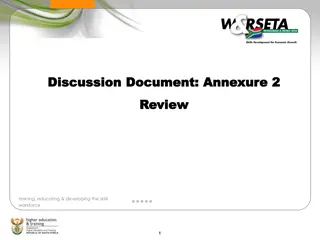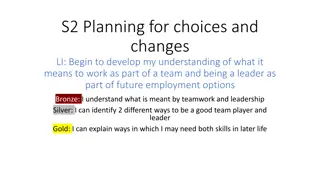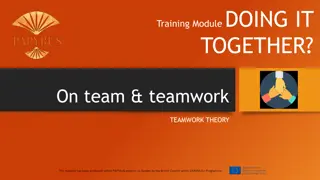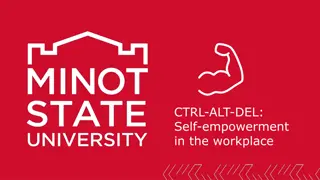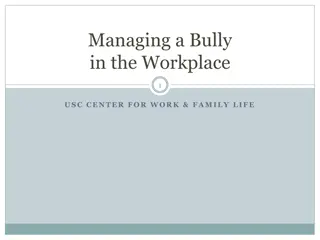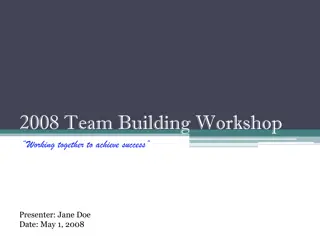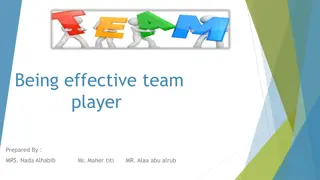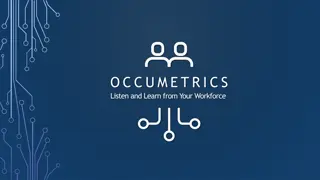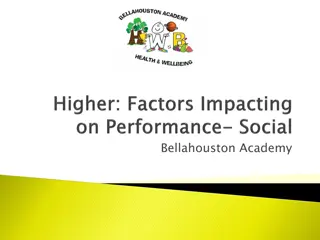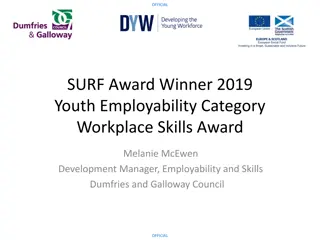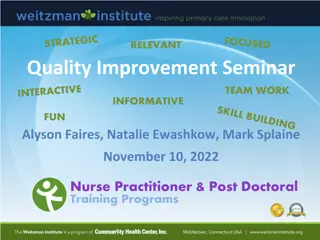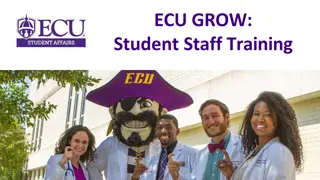Enhancing Teamwork Skills in the Workplace
Explore positive character traits, benefits of teamwork, and characteristics of a good teammate. Engage in activities to develop teamwork skills such as building structures and taking surveys. Discover the impact of teamwork through narratives, quotes, and real-life examples. Unleash the power of collaboration for success-driven results.
Download Presentation

Please find below an Image/Link to download the presentation.
The content on the website is provided AS IS for your information and personal use only. It may not be sold, licensed, or shared on other websites without obtaining consent from the author.If you encounter any issues during the download, it is possible that the publisher has removed the file from their server.
You are allowed to download the files provided on this website for personal or commercial use, subject to the condition that they are used lawfully. All files are the property of their respective owners.
The content on the website is provided AS IS for your information and personal use only. It may not be sold, licensed, or shared on other websites without obtaining consent from the author.
E N D
Presentation Transcript
Bell Ringer Make a list of positive character traits that you posses and how they could be applied in the workplace.
Bell Ringer: 3/13 Describe 3-4 features of a game system, computer, phone, car, tool, or other product that you re trying to get someone to buy. Now explain how those features are a benefit to the potential buyer of that product. For example: Feature: High Definition Screen Benefit: The high def screen will allow the viewer to see movies in the highest definition, allowing them to see things that wouldn t have been possible with a regular TV.
Bell Ringer: 3/14: Start a new set of bellringers with the heading Teamwork Write a narrative (2-3 paragraphs) about teamwork and what it means to you. You could describe a time where teamwork (or the lack of it) impacted your pursuit of a goal. How can teamwork be applied to the workplace?
Al Pacino quotes Vince Lombardi, Inch by Inch, mixed with an array of other media to articulate success driven by teamwork!
Bell Ringer: 3/15-16 What are some characteristics of a good teammate? What are the various roles each team needs in order to be successful? Be prepared to share out with the class.
Teamwork Challenge Your task is to build a structure out of newspaper and tape. This structure must meet three requirements: 1.Be at least 18 inches tall 2.Be able to support the weight of a softball for 10 seconds 3.Be able to withstand the force of a fan for 10 seconds Before starting, please write a prediction on your bell ringers of what you think will happen during this activity.
Bell Ringer: 3/20 Teamwork 1.Take the teamwork inventory survey 1.Review your answers and reflect on what it says about your teamwork skills.
Bell Ringer: Networking 3/22-23 1.What are some important things to do/prepare for prior to a networking meeting. 1.What effect has technology had on young people s ability to communicate in a face-to-face manner? What are some of the pros and cons of technology when it comes to communication (all forms: verbal, nonverbal, written, and aural)?
Bell Ringer: 4/3 Write down a list of things/behaviors you need from your classmates in order for this to a be a successful learning environment. Why are these things important to you? How can we build a stronger classroom together?
Bell Ringer: 4/4 Staple together your networking bell ringer sheets. They should include: Networking questions, email etiquette worksheet, and yesterday s bell ringer and worksheet. Start a new page for bell ringers titled: Problem Solving and Critical Thinking after passing forward your Networking Bell Ringers.
Bell Ringer: 4/4: Brian has the perfect summer job, thanks to his dad. But when Brian finds out that some of his co-workers (including some with families to support) make significantly less money than he does even though they've been there much longer, he feels conflicted. What should he do? 1-2 paragraphs to explain your answer. When you finish, take time to finish yesterday s work or work silently on something for another class. I will collect your networking bell ringers this period.
Problem Solving and Critical Thinking Read the article and take notes using the cornell notes system. Be sure to follow the format, Taking notes on the right-side first, underlining the key words in your notes, specify key points on the left, and then writing a 1-paragraph summary of the article at the bottom of the page.
Bell-Ringer: 4/10 If you haven t already, start a Problem Solving and Critical Thinking Bell-Ringer sheet. In the following video, try to identify some potential issues in the team s problem solving attempt.
this time theyre solving a cinema problem which ends in a simple way
Big Bang Theory without the laugh track isnt funny, its sad. What were the main issues this team faced?
http://www.ted.com Tom Wujec from Autodesk presents some surprisingly deep research into the "marshmallow problem" -- a simple team-building exercise that involves dry spaghetti, one yard of tape and a marshmallow. Who can build the tallest tower with these ingredients? And why does a surprising group always beat the average? TEDTalks is a daily video podcast of the best talks and performances from the TED Conference, where the world's leading thinkers and doers give the talk of their lives in 18 minutes. Featured speakers have included Al Gore on climate change, Philippe Starck on design, Jill Bolte Taylor on observing her own stroke, Nicholas Negroponte on One Laptop per Child, Jane Goodall on chimpanzees, Bill Gates on malaria and mosquitoes, Pattie Maes on the "Sixth Sense" wearable tech, and "Lost" producer JJ Abrams on the allure of mystery. TED stands for Technology, Entertainment, Design, and TEDTalks cover these topics as well as science, business, development and the arts. Closed captions and translated subtitles in a variety of languages are now available on TED.com, at http://www.ted.com/translate. Watch a highlight reel of the Top 10 TEDTalks at http://www.ted.com/index.php/talks/top10
Marshmallow Tower What group was surprisingly successful? Why? Who did the worst? Why?
Bell Ringer: 4-11 The job interview is one of the first times you get to showcase how well you can think on your feet. Interviewers will often ask you behavioral questions in addition to technical questions about the actual job. It s important to have a plan for answering them on the spot- it s an important skill. What types of questions do you expect to be asked when in a job interview? Provide 2-3 examples of questions and respond to them as you would in an interview.
Bell Ringer: 4/12-13 Think about how you perceive yourself and how others perceive you. Do you think both are the same? Explain. What are some things you can do to change others perception of you?
What would you do? 1.Your boss is talking to another employee as you walk into work. You have reason to believe they are talking about you. This makes you feel uncomfortable and upset. 1.A close friend gets to go on a senior trip, all expenses paid. You are jealous that this friend doesn t have to pay a dime- his or her parents are paying for everything. You consider not going because you have to pay for part of your trip and don t think it s fair.
What would you do? 3. makes it easier for the office staff to find documents. You think your supervisor is going to take all the credit. At work, you developed a new way to organize the filing system that 4. is always finding fault in everything you do, and is making your life miserable. You are a nurse. The patient you are working with is ungrateful and rude,
Conclusion As a group, discuss some of the strategies you might use when faced with a situation similar to the ones in this activity. Is there a right or wrong way to respond? Are there certain things you should always try to do? If so, what are they?
Bell Ringer: 4/14- Professionalism In your own words, define professionalism and what it means to you. How can you display professionalism in school, the workplace, and in the community?
Bell Ringer: 4/17 Think about a time when someone made a biased judgement about you or acted unfairly toward you because of your age, skin color, clothes you were wearing, gender, the way you speak, where you live, how much money your family has, or some other reason. Why do you think those assumptions were made about you? How did that experience make you feel? How do you think you should have been treated in that situation?
Discussion Questions What do you think the older generations think about your generation? What does your generation think of the older generations? Do you think these ideas are always true? Sometimes true? Never true? Why do you think each group has different ideas about other groups?
Setup the classroom Working as a team, create six stations around the room by placing two desks together with chairs around them at six different points around the room. After the classroom is set up, fill in each station with even groups.
The Cultural Divide Today s workforce is very diverse. People of different ages and backgrounds are working alongside one another more so today than ever before. The purpose of this activity is to consider how we perceive others and how others may perceive us, as well as whether or not these perceptions paint an accurate picture of who we are. At each station, consider the following situations and discuss them in your group. After two minutes we will rotate to the next station and repeat the process. After completing all the stations we ll take some time to discuss our findings with the class. Good Luck!
Bridging the gap What steps can you take to bridge the gap between generations? Write down four things your generation can do to meet the needs/expectations of older generations. Write down four things older generations can do to meet the needs/expectations of your generation.
Steps to bridge a cultural divide Look past stereotypes Find common ground Learn from each other Listen to each other Acknowledge and appreciate differences Promote intergenerational discussions
Simon Sinek explains how the millennial generation became so entitled. A combination of failed parenting strategies, technology, impatience and environment have created a wave of young people who can't hack it in the real world.
Reflection: What are your opinions on the video? What things did you agree/disagree with? What are the biggest problems facing young people entering the workforce?
Not a Bell-Ringer: 4/19-20 Imagine it is your first day on a new job. Discuss what you would do to make a good impression on your co-workers and supervisors (make a list). Why might it be important to make a good impression on your first day?
Conclusion Describe Justin s work attitude. What do you think the most difficult part of being Justin s supervisor would be? How can a supervisor or boss affect your performance? How can co-worker attitudes affect your performance?
Bell-Ringer: 4-21 One major aspect of professionalism in the workplace is being a team player. Do you have a me or we attitude when it comes to work? What effect might that attitude have on your success in the workplace?
Bell-Ringer: 4/24 -What does the term self-reflection mean to you? Think about a time you needed to solve a personal problem and you acted first and then reflected later. Now think about a time when you needed to solve a problem and you reflected first and then acted. Which way turned out the best for you? Why do you think this is?
Continued The following exercise will get you thinking about your future. You will be asked to think about what you want to do with your future and define some life goals by working backwards in time. I m going to ask you a series of questions. You will need to think about these questions carefully and then either draw or write your reactions on your paper. Your responses don t need to be in any particular order, but will ultimately help you tell or retell your own personal history.









